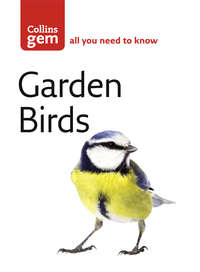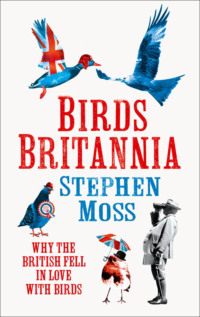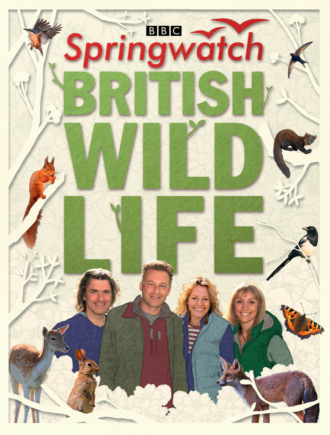
Полная версия
Springwatch British Wildlife: Accompanies the BBC 2 TV series
All three birds often choose a high perch from which to deliver their songs, which makes them easy to see. This is a good time of year to get to grips with the differences between them. Male blackbirds are easy: coal-black in colour, with that distinctive bright custard-yellow bill and – if you get close enough to see it – a yellow ring around the eye. Female blackbirds, which tend to be more skulking in habit, are chocolate-brown above and below.
The two thrushes are harder to tell apart, though with practice not too tricky. The mistle thrush is much larger, paler and greyer, with heavy spotting below and a permanently surprised expression on its face. Song thrushes are smaller, plumper and a deeper brown colour, and with a much more kindly expression! Beware young blackbirds, especially in late summer, which can be a bit streaky below and a little thrush-like.
These birds’ nests are easy to find too, often tucked away in a shrub or bush or, in the case of the mistle thrush, in the fork of a tree. All three start to breed very early on, and sometimes have eggs (and occasionally even chicks) before Christmas or early in the new year. The two thrushes have two broods – the song thrush sometimes three – but blackbirds really are the champion nesters, often raising three, four or even five broods of chicks in a single breeding season. This avoids the ‘putting all your eggs in one basket’ problem faced by blue tits, and means that even if there is prolonged bad weather during some parts of the breeding season, they can usually get at least one brood of chicks to fledging.
The blackbird and mistle thrush eat a wide range of foods, including snails and worms as well as berries and fruit – a mistle thrush will often spend the winter defending a single berry bush against all-comers. Song thrushes are more carnivorous, feeding mainly on slugs and snails, which they bash on a heavy stone, known as an ‘anvil’, to get them out of their shells. Song thrushes suffer badly from poisoning by agricultural and garden pesticides, especially slug pellets – being a natural pest controller, they should be welcomed into the garden! In autumn and winter, all three species, but especially blackbirds, will feed on windfall apples.
The availability of food and places where the birds can nest means that gardens are incredibly important for both blackbirds and song thrushes – they nest there in densities up to ten times greater than in their natural woodland habitats.

©John Hawkins/FLPA

©Steve Young/FLPA
Mistle thrush and song thrush enjoy a varied diet, including fruit as well as insects, snails and slugs.
Winter Thrushes & Waxwing

©Erica Olsen/FLPA
©Mike Lane/FLPA
Fieldfare and redwing are two of the commonest species wintering in Britain.
From time to time, as frost and snow take their grip on the British winter, three beautiful and exotic-looking visitors to our shores turn up in our gardens, to the delight of anyone lucky enough to get close views of them.
Two of these winter visitors are members of the thrush family, closely related to the more familiar song and mistle thrushes. The redwing and the fieldfare are often known simply as ‘winter thrushes’, as they come in their millions each autumn from Scandinavia and Iceland to spend the winter months here. Like waders and wildfowl, they do so to take advantage of our relatively mild winter climate compared with places to the north and east of Britain.
Usually they spend most of the time roaming the wider countryside in huge flocks, stripping the hedgerows bare of berries or feeding in muddy fields. But when snow and ice make finding food more difficult, they often head into our gardens in search of windfall apples, berry bushes and other food we provide.
Of the two, the redwing is by far the most familiar. Our smallest thrush, it is a shade shorter than the song thrush, with darker brown upper parts, spotted under parts, and a distinctive creamy stripe above the eye. Its name comes from the orange-red patch on its flanks, which is more obvious as the bird takes to the air, lifting its wings.
The fieldfare is even more colourful: a large bird, almost as big as a mistle thrush, with a long tail, grey head, reddish-brown back and warm yellow on the breast. They look very different from the usual garden birds, so much so that when they invaded our gardens a couple of winters ago, there were several reports of ‘cuckoos’ in the middle of winter! Like mistle thrushes, fieldfares can be aggressive birds, defending a berry bush against any intruders that might steal their food. But they are less solitary than our two resident species, and usually travel in noisy flocks, chattering to each other as they go.
Both redwings and fieldfares arrive in Britain during October, the redwings usually a week or two ahead of their larger cousins. On clear autumn nights, listen out for their distinctive high-pitched call, which people once supposed was made by witches flying overhead on their broomsticks!
Redwings and fieldfares can be seen in the countryside right the way through to March or even April, but once spring has arrived, the vast majority have already left our shores: the fieldfares to Scandinavia and northern Russia; the redwings to Scandinavia and Iceland. Very few remain to breed, which in some ways is odd, given the huge numbers wintering here, and the fact that fieldfares, in particular, can be found nesting as far south as Hungary, on the same latitude as southern Britain.
The third member of this winter trio is even more exotic than the other two. Waxwings are starling-sized birds with a delicate buffish-brown plumage, black and yellow wings tipped with red – these resemble sealing wax, hence the bird’s name – and a wispy crest, giving them a faintly comical appearance.
Unlike other winter visitors, waxwings are a so-called ‘irruptive’ species, which means that in some years hardly any come to spend the winter in Britain, while in other years there may be tens of thousands. Their appearance here does not, as some suppose, foretell a hard winter. It is simply a reflection of their population level and the amount of food back home in Scandinavia – during years of berry shortages and high numbers of birds, they will head south, otherwise they stay put.
Unlike other rare birds, waxwings rather like our suburbs and gardens, where they can often find plenty of juicy red berries to eat. They also regularly turn up in supermarket car parks, which are often planted with berry-bearing bushes whose fruit appears at just the right time for the waxwings’ arrival.
If you are lucky enough to discover a flock of waxwings feeding in your front garden, be prepared for another invasion – from hordes of eager birders wanting to see this beautiful bird.
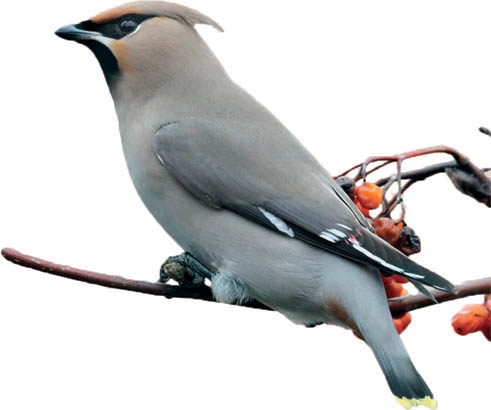
©Gianpiero Ferrari/FLPA
Waxwings may be rare and exotic, but they are often found in gardens where they feed on berry bushes.
Black Crows

©John Eveson/FLPA
©Andrew Parkinson/FLPA
©Winfried Schäfer/Imagebroker/FLPA
Telling apart the rook, carrion crow and raven takes practice, but given good views is reasonably straightforward.
Crows are a bit of a paradox. Few birds are so hated, yet few are so intelligent and fascinating. Why they are so loathed by so many people is a combination of the way they behave and their appearance: there is a long tradition of black birds being associated with evil, and birds don’t come much blacker than some of our crows.
There are four black kinds of crow that you are likely to encounter in Britain: the carrion crow, rook, jackdaw and raven. Then there are two other mainly black species: the hooded crow and chough, though these tend to be confined to more remote northerly and westerly parts of the country.
Of all our birds, perhaps the crows cause the most confusion about their identity. Indeed, for two species, the rook and the carrion crow, it is said that the best way to tell them apart is whether they are in a flock or solitary: a lone bird is supposed to be a crow, whereas a flock of sociable birds is meant to be rooks. Though it is certainly true that the rook is more gregarious than its cousin, and is often found in large feeding flocks on farmland, it is also the case that carrion crows may form large flocks, especially as they go to roost at night. The confusion is made worse by the term ‘scarecrow’: scarecrows were originally made to scare off marauding flocks of rooks, not crows!
So if behaviour isn’t a reliable way to tell them apart, how can we identify them? Well, if you get a reasonable look at a ‘black bird’, you should pay most attention to its overall colouring, especially on the head. Carrion crows are all black, including the bill, giving them a rather sinister appearance, while rooks have a greyish-white bill and face. Rooks are also more slender, with a longer neck and smaller head, and their bills are more pointed. In flight, these two can also be told apart – the rook’s style is floppier, and shows longer, more fingered wings – but it takes a lot of experience to make the distinction.
The rook and carrion crow were once the only two large crows in most of Britain, but now they have been joined in many areas by a third species, the raven. Once persecuted so much that it was seen only in remote parts of the northern and western uplands, the raven has recently spread south and east, and can now be found nesting in Kent. Ravens are huge, bulky, black birds with long wings, a large head, thick neck and massive bill, giving them a very front-heavy appearance as they fly. But the easiest way to confirm the identity of a raven is when it calls: a tremendously deep, grunting croak that you feel as much as hear!
The fourth, mainly black, species of crow, the jackdaw, is much smaller and easier to identify. Its call as it flies overhead is a distinctive ‘chack’, which gave the bird its name. When you see a jackdaw on the ground, it is easy to tell it apart from its larger relatives. Small and compact, it has a short, stubby bill and a very noticeable light grey patch on the back of its neck.
Our remaining two kinds of ‘black’ crow are not widespread. The hooded crow was once thought to be the same species as the carrion crow, but it is actually easy to tell apart, as it has large areas of grey contrasting with the black of its plumage. The ‘hoodie’, as it is often known, replaces the carrion crow in north and west Scotland, Ireland and the Isle of Man. The other species, the chough, has an even smaller range. It can be found only on the Scottish islands of Islay and Jura, in west Wales, western Ireland and, for the past few years, Cornwall. The chough’s return to this English county in the early twenty-first century was cause for great celebration, as the chough is one of three local symbols (the other two being fishing and tin-mining) on the Cornish coat of arms. The name often puzzles people, but, of course, it used to be pronounced ‘chow’, rather than ‘chuff’, and is a representation of the bird’s echoing call.

©Hugh Clark/FLPA
The jackdaw is a sociable bird, often gathering in large, noisy flocks.

©Frans Van Boxtel/FN/Minden/FLPA
©Mike Lane/FLPA
Hooded crow and chough are two of the rarer British members of the crow family.
Magpie & Jay

©ImageBroker/Imagebroker/FLPA
According to the well-known rhyme, a lone magpie is a sign of sorrow.
Of all our garden birds, surely none is so controversial as the two most striking members of the crow family: the magpie and the jay. The magpie is the pantomime villain of our garden birds, seen as a thief who takes eggs and chicks from nests, and also steals shiny trinkets and jewellery. With the possible exception of the sparrowhawk, no other bird comes close in the league table of Britain’s most hated birds. And its reputation spreads far and wide – there is a famous Italian opera titled The Thieving Magpie.
Now that the widespread persecution of all birds is a thing of the past, the magpie population has reasserted itself. The species’ habit of travelling in large, noisy flocks doesn’t help its reputation either. Magpies are not subtle birds, and so we perhaps notice their presence more than we would other predators.
Magpies have adapted very well to living in our gardens. By encouraging smaller birds to feed and nest, we have created a ready supply of food for them and their hungry chicks. And this is surely the point. Just like any other creature, magpies must feed themselves and their offspring. After all, we don’t condemn blue tits for killing and eating thousands of caterpillars, do we?
What is important to realise is that the population of any predator goes up and down depending on the availability of its prey, and not the other way around. Magpies are in no way responsible for the declines of some of our songbird species. Indeed, most garden birds are actually on the increase. It is birds of the wider countryside that are in decline. So why not take a closer look at a magpie, forget any prejudices you might have, and just appreciate what a truly beautiful creature it is? Superficially ‘black and white’, the magpie’s plumage is in fact a subtle mixture of deep greens and blues, and the iridescent feathers are set off by those patches of brilliant white. Magpies are also fascinating to watch, especially early in the year when they collect twigs with which to make their untidy and often obvious nest in the fork of a bare tree. And try to recall that childhood rhyme, ‘One for sorrow, two for joy…’, which was borrowed by the makers of the celebrated children’s TV series Magpie, and which has been sung by generations of British children.
Jays are even more beautiful than their black and white cousins, but, being much shyer birds, they are not quite as familiar. One Victorian birdwatcher and writer described the jay as ‘Britain’s bird-of-paradise’, and Bill Oddie always claims that if someone says they have seen a really unusual bird in their garden, nine times out of ten it is a jay. That pinkish-brown plumage, set off with black and white and a small patch of blue on the wings, those black markings on the side of the face, and the jaunty crest, make the jay one of our most attractive garden birds. However, it must be said that it has the same habit of taking eggs and chicks of songbirds as the magpie, but as it is a lot subtler about doing so, we don’t usually see it happening.
Jays are originally woodland birds but have learned to thrive in our towns and cities, especially those with large, mature trees where the birds can make their nests. Numbers are boosted every autumn with invading jays from continental Europe, which in some ‘invasion years’ may arrive in huge, noisy flocks. Listen out for the jay’s ‘tearing muslin’ call as it competes with the machine-gun rattle of the magpie – the winter soundtrack in our gardens and suburbs.
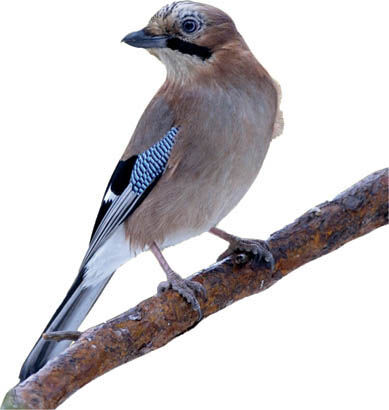
©Malcolm Schuyl/FLPA
Seen well, the jay is one of our most handsome and colourful birds.
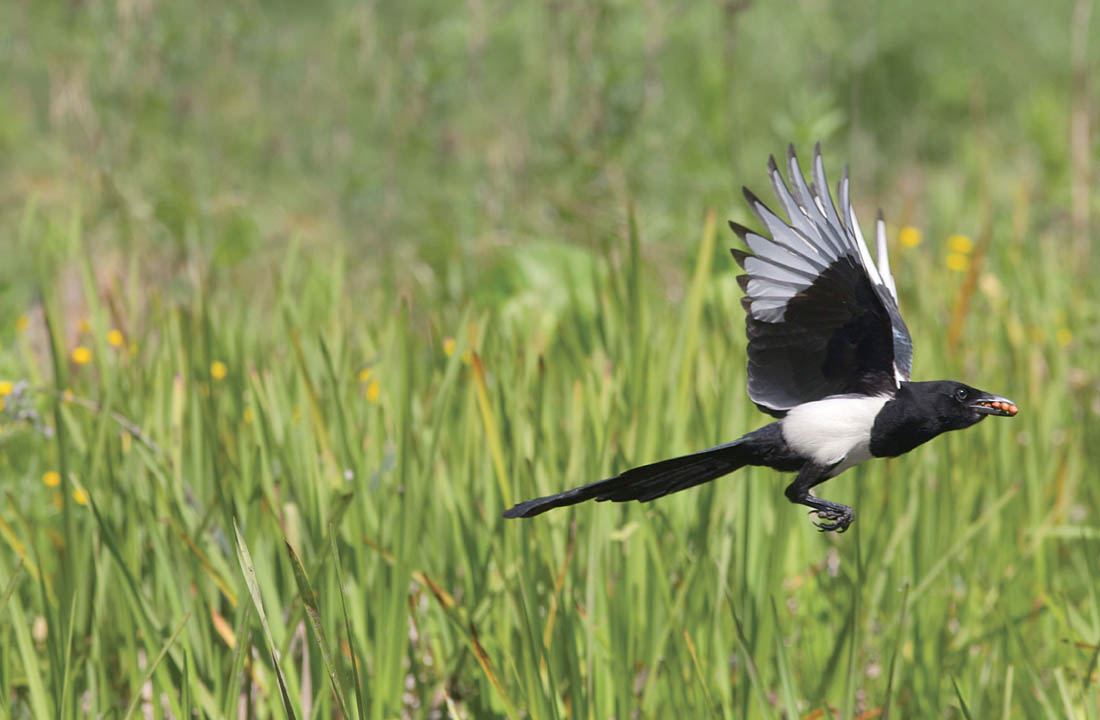
©Erica Olsen/FLPA
Magpies are opportunistic feeders, seeking out food wherever they go.
Конец ознакомительного фрагмента.
Текст предоставлен ООО «ЛитРес».
Прочитайте эту книгу целиком, купив полную легальную версию на ЛитРес.
Безопасно оплатить книгу можно банковской картой Visa, MasterCard, Maestro, со счета мобильного телефона, с платежного терминала, в салоне МТС или Связной, через PayPal, WebMoney, Яндекс.Деньги, QIWI Кошелек, бонусными картами или другим удобным Вам способом.




